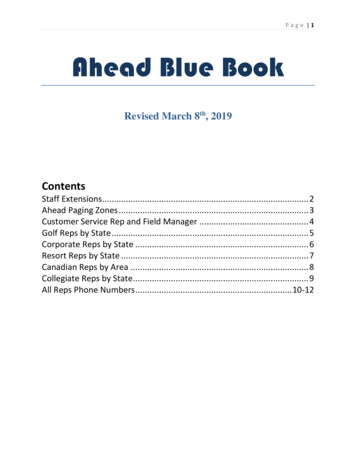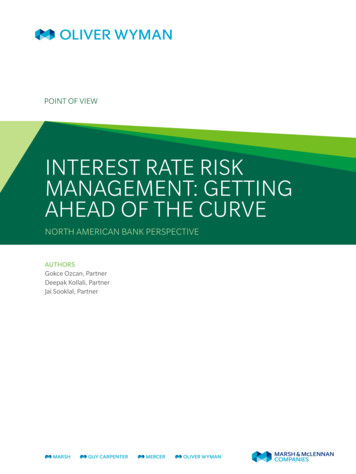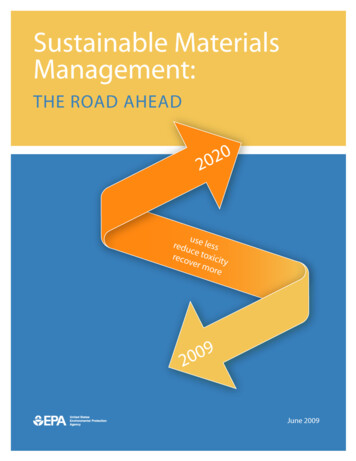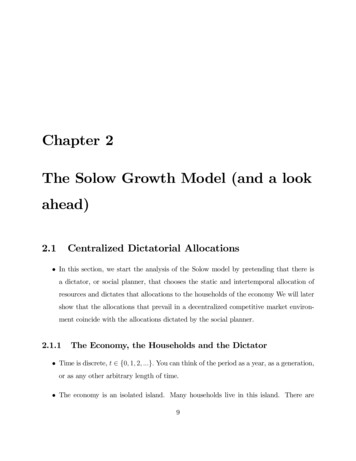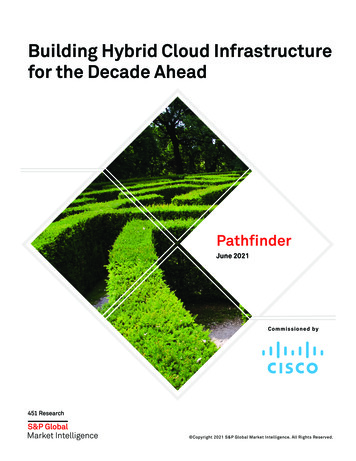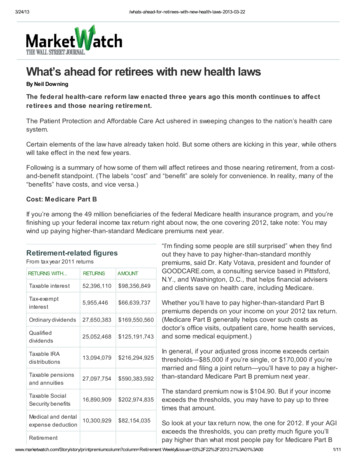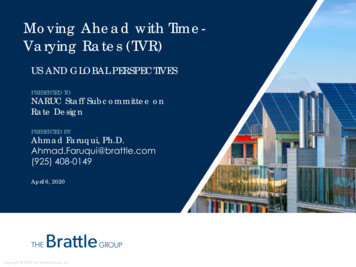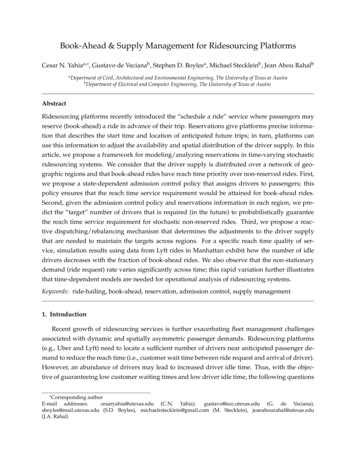
Transcription
Book-Ahead & Supply Management for Ridesourcing PlatformsCesar N. Yahiaa, , Gustavo de Vecianab , Stephen D. Boylesa , Michael Steckleinb , Jean Abou Rahalba Departmentof Civil, Architectural and Environmental Engineering, The University of Texas at Austinof Electrical and Computer Engineering, The University of Texas at Austinb DepartmentAbstractRidesourcing platforms recently introduced the “schedule a ride” service where passengers mayreserve (book-ahead) a ride in advance of their trip. Reservations give platforms precise information that describes the start time and location of anticipated future trips; in turn, platforms canuse this information to adjust the availability and spatial distribution of the driver supply. In thisarticle, we propose a framework for modeling/analyzing reservations in time-varying stochasticridesourcing systems. We consider that the driver supply is distributed over a network of geographic regions and that book-ahead rides have reach time priority over non-reserved rides. First,we propose a state-dependent admission control policy that assigns drivers to passengers; thispolicy ensures that the reach time service requirement would be attained for book-ahead rides.Second, given the admission control policy and reservations information in each region, we predict the “target” number of drivers that is required (in the future) to probabilistically guaranteethe reach time service requirement for stochastic non-reserved rides. Third, we propose a reactive dispatching/rebalancing mechanism that determines the adjustments to the driver supplythat are needed to maintain the targets across regions. For a specific reach time quality of service, simulation results using data from Lyft rides in Manhattan exhibit how the number of idledrivers decreases with the fraction of book-ahead rides. We also observe that the non-stationarydemand (ride request) rate varies significantly across time; this rapid variation further illustratesthat time-dependent models are needed for operational analysis of ridesourcing systems.Keywords: ride-hailing, book-ahead, reservation, admission control, supply management1. IntroductionRecent growth of ridesourcing services is further exacerbating fleet management challengesassociated with dynamic and spatially asymmetric passenger demands. Ridesourcing platforms(e.g., Uber and Lyft) need to locate a sufficient number of drivers near anticipated passenger demand to reduce the reach time (i.e., customer wait time between ride request and arrival of driver).However, an abundance of drivers may lead to increased driver idle time. Thus, with the objective of guaranteeing low customer waiting times and low driver idle time, the following questions CorrespondingauthorE-mail addresses:cesaryahia@utexas.edu (C.N. Yahia),gustavo@ece.utexas.edu (G. de Veciana),sboyles@mail.utexas.edu (S.D. Boyles), michaelrstecklein@gmail.com (M. Stecklein), jeanabourahal@utexas.edu(J.A. Rahal)
arise: how many drivers should a ridesourcing platform supply?, and, how should the platformspatially manage idle drivers based on anticipated demand?In this article, the primary objective is to investigate the role of book-ahead/reserved rides onthe management of driver supply. Reservations give precise information characterizing the starttime and location of anticipated trips; in turn, the platform can use this information to adjust theavailability and spatial distribution of its driver supply. Thus, given a reach time service requirement that the platform seeks to maintain, we analyze the impact of reservations on the numberof drivers supplied throughout the network. Moreover, since passengers that schedule a ride inadvance expect the driver to arrive within a desired pickup window, our analysis incorporatessuch priority of book-ahead rides over non-reserved rides.In practice, ridesourcing platforms have several control levers that they can use to managedriver supply. These levers include earning guarantees for new drivers, bonuses, and heat mapsthat show high demand locations where drivers earn more due to surge pricing (Lyft, 2019a,c). Inaddition, as implemented by Lyft in New York City, platforms can restrict the number of activedrivers or force them to drive towards high demand areas if they wish to remain online (Lyft,2019b).The proposed supply management framework parallels existing research on ridesourcing systems (Djavadian and Chow, 2017; Lei et al., 2019; Wang and Yang, 2019). The majority of existingstudies assume a fixed number of driver supply and/or steady-state (equilibrium) conditions.However, it is increasingly apparent that demand and supply patterns in ridesourcing systemsare time-varying. In addition, these variations in demand and supply occur at a fast pace, and thesystem may never attain a steady state equilibrium.Thus, our proposed framework for analyzing reservations in ridesourcing systems focuses onthe transient nature of time-varying stochastic demand/supply patterns. Precisely, for any futurepoint in time, we seek to probabilistically characterize the total number of active (non-idle) drivers;this time-dependent probabilistic characterization is determined by the fraction of book-aheadrides, the stochasticity of non-reserved rides, the anticipated time-varying profile of book-aheadrides, and control policies that aim to maintain reach time priority for book-ahead rides. In moredetail, as shown in Figure 1, the proposed framework consists of the following three componentsfor managing driver supply:1. We develop a state-dependent admission control policy that assigns drivers to passengers.The objective of this control policy is to guarantee the reach time service requirement forbook-ahead rides. Effectively, the admission control policy ensures that there is a sufficientnumber of drivers near the location of anticipated book-ahead rides such that the driver canreach the passenger within the pickup window.2. Given this admission control policy and reservations information, we predict the “target”number of drivers that is required (in the future) to probabilistically guarantee the reach timeservice requirement for stochastic non-reserved rides. The target computations are derived2
Figure 1: Proposed framework for computing the target supply that probabilistically guarantees the reachtime service requirement, assigning drivers to passengers to guarantee the arrival of drivers to book-aheadrides within the pickup window, and rebalancing drivers across regions to maintain the targets.from an upper bound on the time-dependent probability that a non-reserved ride will experience waiting times in excess of the reach time service requirement, and this upper boundcan be evaluated using transient analysis of Mt /GI/ queues.3. We develop a minimum cost flow driver dispatching/rebalancing mechanism that seeks tomaintain the targets across regions. In particular, due to the transition of drivers across geographic regions and the associated passenger demand patterns, the driver supply in a specific region may deviate from the predicted target. Thus, the proposed minimum cost flowmechanism determines the adjustments to the driver supply that are needed to maintain thetargets throughout the network.The remainder of this article proceeds as follows: In Section 2 we review related work addressing operation of ridesourcing systems. Section 3 describes the proposed model for analyzingtime-dependent ridesourcing dynamics. Section 4 presents the admission control policy. Section 5derives an upper bound on the performance of the admission control policy and computes the target supply. Section 6 presents the driver dispatching/rebalancing mechanism. Section 7 exhibitssimulation results using data from Lyft operations in Manhattan. Section 8 concludes the article.2. Related WorkRidesourcing platforms are aggressively implementing supply and demand management strategies that drive their expansion into new markets (Nie, 2017). These strategies can be broadly classified into one or more of the following categories: pricing, fleet sizing, empty vehicle routing(rebalancing), or matching passengers to drivers. Apart from increasing their market share, platforms seek to improve their operational efficiency by minimizing the spatio-temporal mismatchbetween supply and demand (Zuniga-Garcia et al., 2020). In this section, we provide a brief surveyof existing methods that are used to analyze the operations of ridesourcing platforms.3
2.1. Equilibrium analysis of ridesourcing systemsThe majority of existing studies on ridesourcing systems focus on analyzing interactions between driver supply and passenger demand under static equilibrium conditions. These studiesseek to evaluate the market share of ridesourcing platforms, competition among platforms, andthe impact of ridesourcing platforms on traffic congestion (Bahat and Bekhor, 2016; Ban et al.,2019; Di and Ban, 2019; Qian and Ukkusuri, 2017; Wang et al., 2018). In addition, following Yangand Yang (2011), researchers examined the relationship between customer wait time, driver searchtime, and the corresponding matching rate at market equilibrium (Xu et al., 2019; Zha et al., 2016).Recently, Di et al. (2018) incorporated ridesharing user equilibrium in a network design problem;Zha et al. (2018) proposed an equilibrium model to investigate the impact of surge pricing ondriver work hours; Zhang and Nie (2019) studied passenger pooling under market equilibriumfor different platform objectives and regulations; and Rasulkhani and Chow (2019) generalized astatic many-to-one assignment game that finds equilibrium through matching passengers to a setof routes. While static equilibrium analysis provides valuable strategic decision-making insights,it fails to address stochasticity and time-dependence in ridesourcing dynamics.2.2. Steady state analysis of stochasticity in ridesourcing systemsTo investigate stochasticity in demand/supply management, researchers have developed queueing theoretic models for ridesourcing systems. In particular, closed queueing networks were usedto analyze rebalancing and pricing policies (Banerjee et al., 2017; Braverman et al., 2019; Zhang andPavone, 2016). In these closed queueing networks, the difficulty in designing supply managementstrategies arises from equilibrium (steady-state) constraints that result in high dimensional nonconvex problems (Banerjee et al., 2017). Other queueing based approaches include a double-endedqueue to characterize stochasticity in matching (Xu et al., 2019) and an M/G/N queue where eachdriver is considered to be a server (Li et al., 2019). Spatial stochasticity associated with matching was also investigated using Poisson processes to describe the distribution of drivers near apassenger (Chen et al., 2019; Zhang et al., 2019; Zhang and Nie, 2019). The previously mentionedstudies focus on steady-state (equilibrium) analysis that disregards the time-dependent variabilityin demand/supply patterns. Furthermore, temporal variations in demand/supply patterns mayoccur rapidly, and the system may not attain the steady-state equilibrium conditions (Bravermanet al., 2019; Ozkan and Ward, 2019). In addition, policies generated from steady-state optimizationin closed queueing networks are open-loop (static); this implies that the policies do not react tothe time-dependent stochastic state of the system.2.3. Time-varying ridesourcing dynamicsThe importance of time dynamics has been emphasized in recent articles that design timedependent demand/supply management strategies (Ramezani and Nourinejad, 2018). Wanget al. (2019) proposed a dynamic user equilibrium approach for determining the optimal timevarying driver compensation rate. Similarly, Nourinejad and Ramezani (2019) developed a dynamic model to study pricing strategies; their model allows for pricing strategies that incur losses4
to the platform over short time periods (driver wage greater than trip fare), and they emphasizedthat time-invariant static equilibrium models are not capable of analyzing such policies. An alternative dynamic model was proposed by Daganzo and Ouyang (2019); however, the authorsfocus on the steady-state performance of their model. While these models can be used to analyzetime-dependent policies, the authors do not explicitly consider the spatio-temporal stochasticitythat results in the mismatch between supply and demand.2.4. Analysis of stochasticity in time-varying ridesourcing dynamicsThe most common approach for analyzing time-dependent stochasticity in ridesourcing systems is to apply steady-state probabilistic analysis over fixed time intervals. For example, whenvalidating their probabilistic model for characterizing passenger waiting time, Chen et al. (2019)calibrated four different models corresponding to distinct time periods. Similarly, Yang et al.(2020) investigated online matching where the platform makes sequential steady-state probabilistic predictions over successive time intervals.However, in the context of driver rebalancing, experimental analysis by Braverman et al. (2019)suggests that the time needed to converge to steady-state (equilibrium) in ridesourcing systems ison the order of 10 hours. Thus, since parameters (e.g., passenger arrival rate) vary over muchshorter time intervals, the system would not reach the steady-state condition. Subsequently,Braverman et al. (2019) proposed a time-dependent look-ahead policy that can be used to makerebalancing decisions at any point in time. Recent studies that addressed operational challenges inridesourcing systems also advocate for transient analysis instead of steady-state models (Nourinejad and Ramezani, 2019; Ozkan and Ward, 2019).Another limitation of steady-state policies is that they are independent of the system state.In particular, those policies are based on probabilistic predictions over fixed time intervals, andthey do not react to the stochastic system state that is rea
These levers include earning guarantees for new drivers, bonuses, and heat maps that show high demand locations where drivers earn more due to surge pricing (Lyft, 2019a,c). In addition, as implemented by Lyft in New York City, platforms can restrict the number of active drivers or force them to drive towards high demand areas if they wish to remain online (Lyft, 2019b). The proposed supply .
